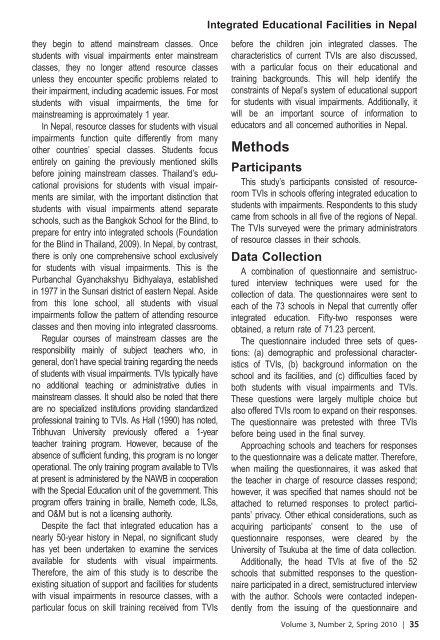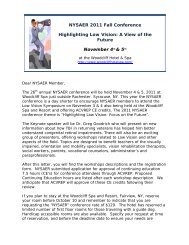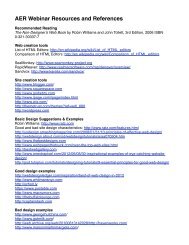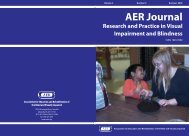Association for Education and Rehabilitation of the Blind - AER Online
Association for Education and Rehabilitation of the Blind - AER Online
Association for Education and Rehabilitation of the Blind - AER Online
You also want an ePaper? Increase the reach of your titles
YUMPU automatically turns print PDFs into web optimized ePapers that Google loves.
<strong>the</strong>y begin to attend mainstream classes. Once<br />
students with visual impairments enter mainstream<br />
classes, <strong>the</strong>y no longer attend resource classes<br />
unless <strong>the</strong>y encounter specific problems related to<br />
<strong>the</strong>ir impairment, including academic issues. For most<br />
students with visual impairments, <strong>the</strong> time <strong>for</strong><br />
mainstreaming is approximately 1 year.<br />
In Nepal, resource classes <strong>for</strong> students with visual<br />
impairments function quite differently from many<br />
o<strong>the</strong>r countries’ special classes. Students focus<br />
entirely on gaining <strong>the</strong> previously mentioned skills<br />
be<strong>for</strong>e joining mainstream classes. Thail<strong>and</strong>’s educational<br />
provisions <strong>for</strong> students with visual impairments<br />
are similar, with <strong>the</strong> important distinction that<br />
students with visual impairments attend separate<br />
schools, such as <strong>the</strong> Bangkok School <strong>for</strong> <strong>the</strong> <strong>Blind</strong>, to<br />
prepare <strong>for</strong> entry into integrated schools (Foundation<br />
<strong>for</strong> <strong>the</strong> <strong>Blind</strong> in Thail<strong>and</strong>, 2009). In Nepal, by contrast,<br />
<strong>the</strong>re is only one comprehensive school exclusively<br />
<strong>for</strong> students with visual impairments. This is <strong>the</strong><br />
Purbanchal Gyanchakshyu Bidhyalaya, established<br />
in 1977 in <strong>the</strong> Sunsari district <strong>of</strong> eastern Nepal. Aside<br />
from this lone school, all students with visual<br />
impairments follow <strong>the</strong> pattern <strong>of</strong> attending resource<br />
classes <strong>and</strong> <strong>the</strong>n moving into integrated classrooms.<br />
Regular courses <strong>of</strong> mainstream classes are <strong>the</strong><br />
responsibility mainly <strong>of</strong> subject teachers who, in<br />
general, don’t have special training regarding <strong>the</strong> needs<br />
<strong>of</strong> students with visual impairments. TVIs typically have<br />
no additional teaching or administrative duties in<br />
mainstream classes. It should also be noted that <strong>the</strong>re<br />
are no specialized institutions providing st<strong>and</strong>ardized<br />
pr<strong>of</strong>essional training to TVIs. As Hall (1990) has noted,<br />
Tribhuvan University previously <strong>of</strong>fered a 1-year<br />
teacher training program. However, because <strong>of</strong> <strong>the</strong><br />
absence <strong>of</strong> sufficient funding, this program is no longer<br />
operational. The only training program available to TVIs<br />
at present is administered by <strong>the</strong> NAWB in cooperation<br />
with <strong>the</strong> Special <strong>Education</strong> unit <strong>of</strong> <strong>the</strong> government. This<br />
program <strong>of</strong>fers training in braille, Nemeth code, ILSs,<br />
<strong>and</strong> O&M but is not a licensing authority.<br />
Despite <strong>the</strong> fact that integrated education has a<br />
nearly 50-year history in Nepal, no significant study<br />
has yet been undertaken to examine <strong>the</strong> services<br />
available <strong>for</strong> students with visual impairments.<br />
There<strong>for</strong>e, <strong>the</strong> aim <strong>of</strong> this study is to describe <strong>the</strong><br />
existing situation <strong>of</strong> support <strong>and</strong> facilities <strong>for</strong> students<br />
with visual impairments in resource classes, with a<br />
particular focus on skill training received from TVIs<br />
Integrated <strong>Education</strong>al Facilities in Nepal<br />
be<strong>for</strong>e <strong>the</strong> children join integrated classes. The<br />
characteristics <strong>of</strong> current TVIs are also discussed,<br />
with a particular focus on <strong>the</strong>ir educational <strong>and</strong><br />
training backgrounds. This will help identify <strong>the</strong><br />
constraints <strong>of</strong> Nepal’s system <strong>of</strong> educational support<br />
<strong>for</strong> students with visual impairments. Additionally, it<br />
will be an important source <strong>of</strong> in<strong>for</strong>mation to<br />
educators <strong>and</strong> all concerned authorities in Nepal.<br />
Methods<br />
Participants<br />
This study’s participants consisted <strong>of</strong> resourceroom<br />
TVIs in schools <strong>of</strong>fering integrated education to<br />
students with impairments. Respondents to this study<br />
came from schools in all five <strong>of</strong> <strong>the</strong> regions <strong>of</strong> Nepal.<br />
The TVIs surveyed were <strong>the</strong> primary administrators<br />
<strong>of</strong> resource classes in <strong>the</strong>ir schools.<br />
Data Collection<br />
A combination <strong>of</strong> questionnaire <strong>and</strong> semistructured<br />
interview techniques were used <strong>for</strong> <strong>the</strong><br />
collection <strong>of</strong> data. The questionnaires were sent to<br />
each <strong>of</strong> <strong>the</strong> 73 schools in Nepal that currently <strong>of</strong>fer<br />
integrated education. Fifty-two responses were<br />
obtained, a return rate <strong>of</strong> 71.23 percent.<br />
The questionnaire included three sets <strong>of</strong> questions:<br />
(a) demographic <strong>and</strong> pr<strong>of</strong>essional characteristics<br />
<strong>of</strong> TVIs, (b) background in<strong>for</strong>mation on <strong>the</strong><br />
school <strong>and</strong> its facilities, <strong>and</strong> (c) difficulties faced by<br />
both students with visual impairments <strong>and</strong> TVIs.<br />
These questions were largely multiple choice but<br />
also <strong>of</strong>fered TVIs room to exp<strong>and</strong> on <strong>the</strong>ir responses.<br />
The questionnaire was pretested with three TVIs<br />
be<strong>for</strong>e being used in <strong>the</strong> final survey.<br />
Approaching schools <strong>and</strong> teachers <strong>for</strong> responses<br />
to <strong>the</strong> questionnaire was a delicate matter. There<strong>for</strong>e,<br />
when mailing <strong>the</strong> questionnaires, it was asked that<br />
<strong>the</strong> teacher in charge <strong>of</strong> resource classes respond;<br />
however, it was specified that names should not be<br />
attached to returned responses to protect participants’<br />
privacy. O<strong>the</strong>r ethical considerations, such as<br />
acquiring participants’ consent to <strong>the</strong> use <strong>of</strong><br />
questionnaire responses, were cleared by <strong>the</strong><br />
University <strong>of</strong> Tsukuba at <strong>the</strong> time <strong>of</strong> data collection.<br />
Additionally, <strong>the</strong> head TVIs at five <strong>of</strong> <strong>the</strong> 52<br />
schools that submitted responses to <strong>the</strong> questionnaire<br />
participated in a direct, semistructured interview<br />
with <strong>the</strong> author. Schools were contacted independently<br />
from <strong>the</strong> issuing <strong>of</strong> <strong>the</strong> questionnaire <strong>and</strong><br />
Volume 3, Number 2, Spring 2010 | 35







